Prayagraj, a city steeped in history and spirituality, offers a unique blend of ancient temples, historical monuments, and cultural experiences, making it an ideal destination for a family vacation. This article explores the top 10 must-visit places in Prayagraj that will create lasting memories for the entire family.
Also Read….Top 10 Best Mahakumbh 2025:- Things TO Do In Prayagraj Mahakumbh 2025 Mela…click here
10. Akshayavat:
- Significance: A sacred peepal tree believed to have been planted by Lord Brahma himself.
- Family Fun: Visit this ancient tree, offer prayers, and soak in the spiritual ambiance.
Akshayavat: The Immortal Banyan Tree of Prayagraj
The Akshayavat, or the “Indestructible Banyan Tree,” is a revered pilgrimage site in Prayagraj, India. Located near the confluence of the Ganges, Yamuna, and the mythical Saraswati rivers (Triveni Sangam) Prayagraj, this ancient banyan tree holds immense religious and mythological significance.
Mythology and Legends:
- Divine Origin: Hindu mythology associates the Akshayavat with Lord Brahma, the creator god. It is believed that Lord Brahma himself planted this tree, making it a sacred symbol of eternal life and continuity.
- Legends of Immortality: The tree is believed to be indestructible, hence its name “Akshayavat” Prayagraj. Legends tell of numerous attempts to destroy the tree by various rulers, including Mughal emperors, but all efforts proved futile. The tree would miraculously regenerate, symbolizing its divine nature and eternal existence.
- Ramayana Connection: According to the Ramayana, Lord Rama and his wife Sita are believed to have spent three nights under the shade of the Akshayavat Prayagraj during their exile. This association further enhances the tree’s religious and mythological significance.
Religious Significance:
- Pilgrimage Site: The Akshayavat Prayagraj is a major pilgrimage site for Hindus. Devotees believe that offering prayers and circumambulating the tree can grant blessings and fulfill wishes.
- Symbol of Immortality: The tree symbolizes eternal life, resilience, and the enduring power of nature.
- Kumbh Mela: During the Kumbh Mela, a massive religious gathering held in Prayagraj, the Akshayavat witnesses a large influx of pilgrims who come to offer prayers and seek blessings.
Features of the Akshayavat:
- Ancient Tree: The tree is believed to be over 3,000 years old, making it one of the oldest living trees in India.
- Vast Canopy: The banyan tree is known for its expansive canopy, providing shade and shelter to visitors.
- Religious Structures: A temple has been built around the Akshayavat, housing idols of various deities.
- Peaceful Ambiance: The serene atmosphere around the tree provides a peaceful and spiritual experience for visitors.
Visiting the Akshayavat:
- Location: The Akshayavat is located near the Triveni Sangam in Prayagraj.
- Best Time to Visit: The best time to visit is during the Kumbh Mela Prayagraj, which takes place every 12 years.
- Timings: The temple is open to visitors throughout the day.
Conclusion:
The Akshayavat is not just a tree; it is a symbol of faith, hope, and eternal life. This ancient banyan tree, with its rich history and mythological significance, continues to inspire awe and reverence in visitors from all walks of life.
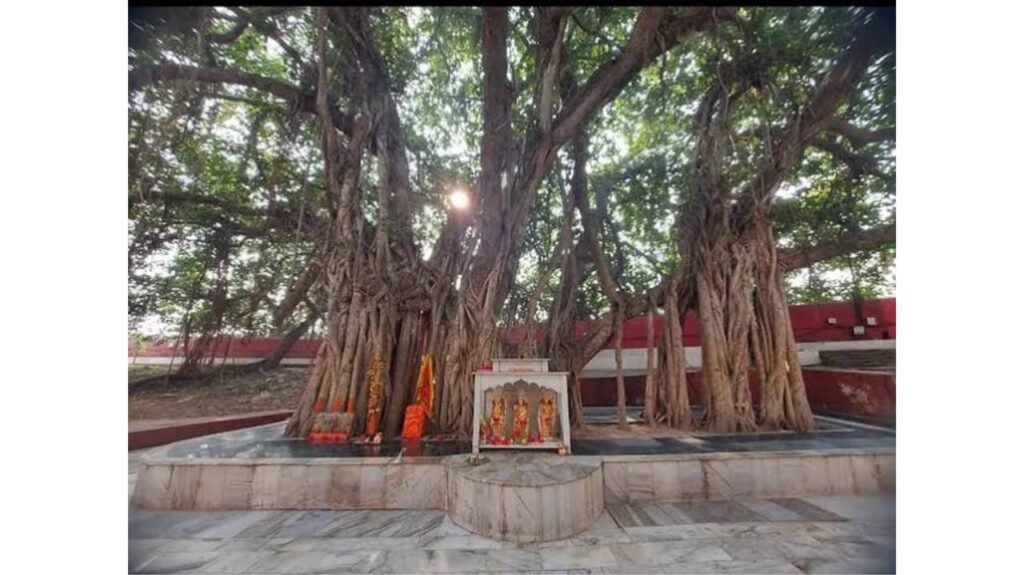
9. Jawahar Planetarium:
- Significance: A popular educational and entertainment center that offers fascinating shows about the universe.
- Family Fun: Explore the wonders of the cosmos through captivating presentations and interactive exhibits.
Jawahar Planetarium: A Journey Through the Cosmos in Prayagraj
The Jawahar Planetarium, located in Prayagraj, Uttar Pradesh, is a captivating destination for families and astronomy enthusiasts of all ages. This educational and entertaining center offers a unique opportunity to explore the wonders of the universe and ignite a passion for space exploration.
A Glimpse into the Celestial World:
- Immersive Shows: The planetarium features state-of-the-art projection systems that create a mesmerizing celestial experience in Prayagraj. The shows typically include captivating visuals of stars, planets, galaxies, and other celestial objects, accompanied by informative narration.
- Educational Programs: The planetarium offers a variety of educational programs designed to engage and educate visitors of all ages. These programs may include interactive exhibits, workshops, and lectures on astronomy and space science.
- Interactive Exhibits: Many planetariums feature interactive exhibits that allow visitors to explore space concepts hands-on. These may include models of spacecraft, telescopes, and other astronomical instruments.
- Special Events: The planetarium may host special events and programs, such as stargazing nights, astronomy camps, and workshops for students.
Why Visit with Family:
- Educational Value: The planetarium offers a fun and engaging way to learn about astronomy and space science, sparking curiosity and wonder in children.
- Family Bonding: Exploring the universe together can be a memorable family experience, fostering shared interests and creating lasting memories.
- Entertainment: The immersive shows and interactive exhibits provide a captivating and entertaining experience for all ages.
- Inspiration: The planetarium can inspire children to pursue careers in science, technology, engineering, and mathematics (STEM) fields.
Tips for Your Visit:
- Check Show Timings: Inquire about show timings and book tickets in advance, especially during peak season.
- Arrive Early: Arrive early to avoid crowds and ensure you get good seats for the show.
- Engage with the Exhibits: Encourage children to interact with the exhibits and ask questions.
- Capture the Memories: Take photos and videos to capture the experience and share it with friends and family.
The Jawahar Planetarium offers a unique and enriching experience for families visiting Prayagraj. It’s a place where wonder and curiosity are ignited, and a lifelong passion for space exploration can be kindled.
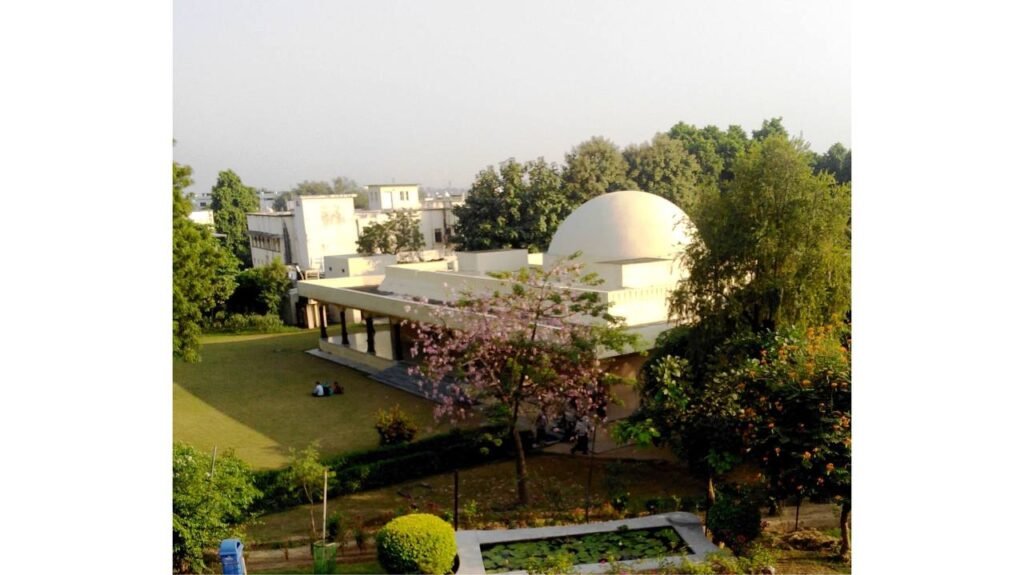
8. All Saints Cathedral:
- Significance: A magnificent Gothic-style cathedral, a significant landmark in Prayagraj.
- Family Fun: Admire the architectural beauty of the cathedral, attend a service (if interested), and enjoy the serene atmosphere.
All Saints Cathedral, Prayagraj: A Gothic Gem in the Heart of India
All Saints Cathedral, often referred to as “Patthar Girja” (Church of Stones), is a prominent landmark in Prayagraj, India. This magnificent structure stands as a testament to the city’s rich history and the enduring influence of British colonial architecture.
A Glimpse into History:
- Construction: The foundation stone for the cathedral was laid in 1871 by Lady Muir, the wife of Sir William Muir, then Lieutenant-Governor of the North-Western Provinces.
- Architectural Marvel: Designed by the renowned British architect Sir William Emerson, the cathedral showcases a striking blend of Gothic Revival architecture with Indian influences.
- Construction Period: The construction spanned several years, with the cathedral finally consecrated in 1887.
Architectural Features:
- Gothic Revival Style:
- Characterized by pointed arches, flying buttresses, intricate tracery, and stained-glass windows.
- The cathedral’s exterior is adorned with intricate stonework and gargoyles, adding to its visual appeal.
- Interior Beauty:
- The interior is equally impressive, featuring high ceilings, stained-glass windows that bathe the space in colorful light, and intricate marble work.
- The nave, the central part of the church, is particularly striking, with its soaring arches and elegant proportions.
Cultural Significance:
- Landmark of Prayagraj: All Saints Cathedral is a prominent landmark in Prayagraj, recognized for its architectural beauty and historical significance.
- Religious Importance: It serves as an important place of worship for the Christian community in Prayagraj.
- Cultural Hub: The cathedral often hosts various cultural events, including concerts, exhibitions, and community gatherings.
Visiting All Saints Cathedral:
- Timing: The cathedral is generally open to visitors throughout the day.
- Dress Code: While there is no strict dress code, it is advisable to dress modestly when visiting any place of worship.
- Photography: Photography is generally permitted within the cathedral, but it is important to be respectful and avoid disturbing services or other visitors.
Conclusion:
All Saints Cathedral is a remarkable testament to architectural brilliance and a significant landmark in Prayagraj. Its Gothic architecture, serene atmosphere, and historical significance make it a must-visit destination for tourists and locals alike. A visit to this iconic cathedral offers a unique glimpse into the city’s rich history and cultural diversity.
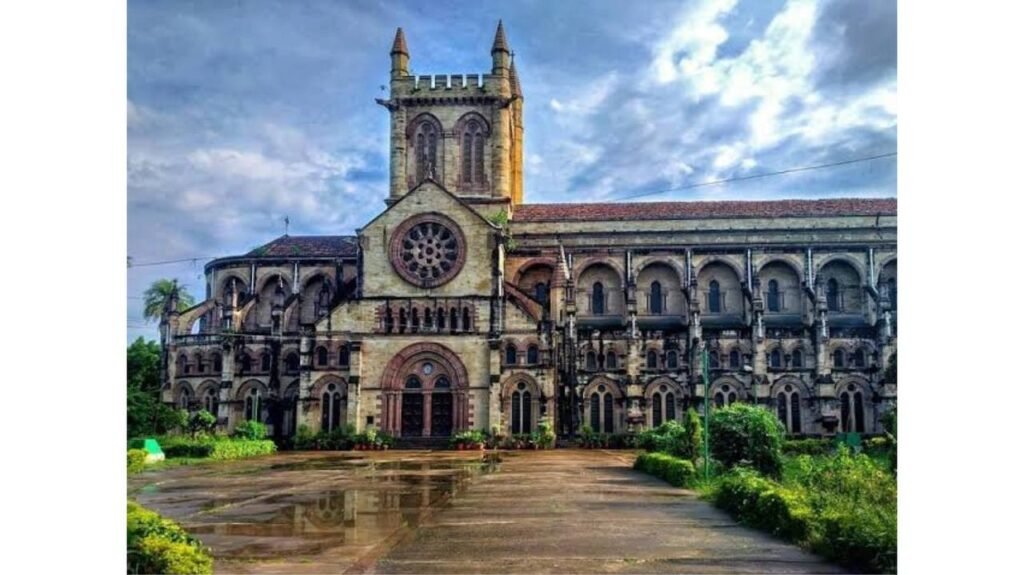
7. Chandrashekhar Azad Park:
- Significance: A beautiful park dedicated to the revolutionary freedom fighter, Chandrashekhar Azad.
- Family Fun: Enjoy a leisurely stroll, relax amidst nature, and learn about the life and struggles of this iconic figure.
Chandrashekhar Azad Park: A Tribute to Freedom
Chandrashekhar Azad Park, sprawling across 133 acres in the heart of Prayagraj, is more than just a green space. It’s a poignant tribute to a legendary freedom fighter and a significant landmark in the city’s history.
A Glimpse into the Past:
- Colonial Origins: Originally named Alfred Park, it was established in 1870 to commemorate the visit of Prince Alfred, the Duke of Edinburgh, to Allahabad.
- A Tribute to a Revolutionary: After India’s independence, the park was renamed in honor of Chandrashekhar Azad, a prominent revolutionary who fought valiantly against British rule. Azad, known for his unwavering commitment to freedom and his famous slogan “Dushman ki goliyon ka jawab sirf goliyon se diya jaata hai” (Only bullets can answer bullets of the enemy), made the ultimate sacrifice within the confines of this park in 1931.
Exploring the Park:
- A Haven of Greenery: The park offers a welcome respite from the urban bustle, featuring lush green lawns, flowerbeds, and a variety of trees. It’s an ideal spot for leisurely walks, picnics, and family outings.
- Historical Significance: The park houses several historical structures, including:
- Chandrashekhar Azad Memorial: A poignant reminder of the revolutionary’s sacrifice, this memorial stands as a symbol of India’s freedom struggle.
- Thornhill Mayne Memorial: A canopy structure built to commemorate the visit of Prince Alfred.
- Allahabad Museum: Located within the park, the museum houses a rich collection of archaeological artifacts and provides insights into the region’s history.
- Recreational Activities: The park offers various recreational facilities, including a children’s play area, jogging tracks, and open spaces for sports activities.
More Than Just a Park:
Chandrashekhar Azad Park Prayagraj is more than just a place of recreation. It serves as a powerful reminder of India’s struggle for independence and the sacrifices made by brave freedom fighters like Chandrashekhar Azad. Visiting the park provides an opportunity to connect with history, reflect on the past, and appreciate the sacrifices made by those who fought for the nation’s freedom.
Key Takeaways:
- Chandrashekhar Azad Park is a significant historical landmark in Prayagraj.
- It offers a blend of history, nature, and recreation.
- Visiting the park provides an opportunity to learn about India’s freedom struggle and pay homage to a legendary revolutionary.
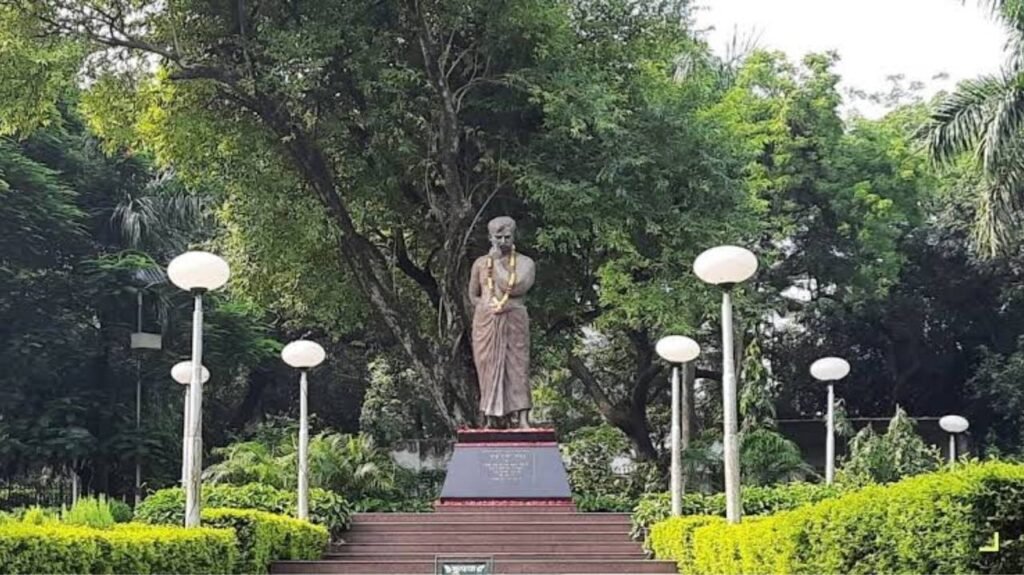
6. Swaraj Bhavan:
- Significance: The former residence of Motilal Nehru, the first President of the Indian National Congress.
- Family Fun: Learn about the Indian freedom struggle and the contributions of the Nehru family to the nation’s independence.
Swaraj Bhavan: A Glimpse into India’s Freedom Struggle
Swaraj Bhavan, a majestic mansion in Prayagraj (formerly Allahabad), holds immense historical significance as the ancestral home of the Nehru-Gandhi family. More than just a residence, it served as a pivotal center for the Indian freedom struggle, witnessing the birth and growth of the nationalist movement.
A Legacy of Freedom:
- From Anand Bhavan to Swaraj Bhavan: Originally named Anand Bhavan (Abode of Bliss), the mansion was acquired by Motilal Nehru, a prominent lawyer and a leading figure in the Indian National Congress. The name was later changed to Swaraj Bhavan in 1930, symbolizing the family’s dedication to the cause of Indian independence.
- A Hub for Nationalists: Swaraj Bhavan became a meeting ground for prominent leaders of the Indian National Congress, including Mahatma Gandhi, Jawaharlal Nehru, and other freedom fighters. The house witnessed numerous discussions, debates, and planning sessions, shaping the course of the Indian independence movement.
- Witness to History: The mansion bears witness to significant events in Indian history. It was here that crucial decisions were made, strategies were devised, and plans for various movements, including the Non-Cooperation Movement and the Civil Disobedience Movement, were formulated.
- A Glimpse into the Nehru Family: Swaraj Bhavan provides a glimpse into the lives of the Nehru family. Visitors can explore the rooms where these iconic figures lived, worked, and entertained guests, gaining a deeper understanding of their personal and political lives.
Exploring Swaraj Bhavan Today:
Today, Swaraj Bhavan functions as a museum, showcasing the history of the Nehru family and their contributions to the Indian independence movement. Visitors can explore the various rooms, including Motilal Nehru’s study, Jawaharlal Nehru’s bedroom, and the dining room, where many historical discussions took place.
The museum houses a collection of photographs, documents, and personal belongings of the Nehru family, offering a fascinating glimpse into their lives and times. A light and sound show provides a captivating narrative of the freedom struggle and the role of the Nehru family in shaping India’s destiny.
Significance for Visitors:
- Historical Significance: Swaraj Bhavan offers a unique opportunity to connect with India’s rich history and understand the sacrifices made by freedom fighters.
- Educational Value: It serves as an educational experience for visitors of all ages, providing insights into the lives and contributions of prominent leaders.
- Cultural Significance: The mansion reflects the architectural style of that era and offers a glimpse into the lifestyle of prominent Indian families during the pre-independence era.
Conclusion:
Swaraj Bhavan is more than just a historical building; it is a testament to India’s struggle for freedom and a symbol of the unwavering spirit of its leaders. A visit to this iconic site provides a valuable opportunity to connect with history, learn from the past, and gain a deeper appreciation for the sacrifices made by those who fought for India’s independence.
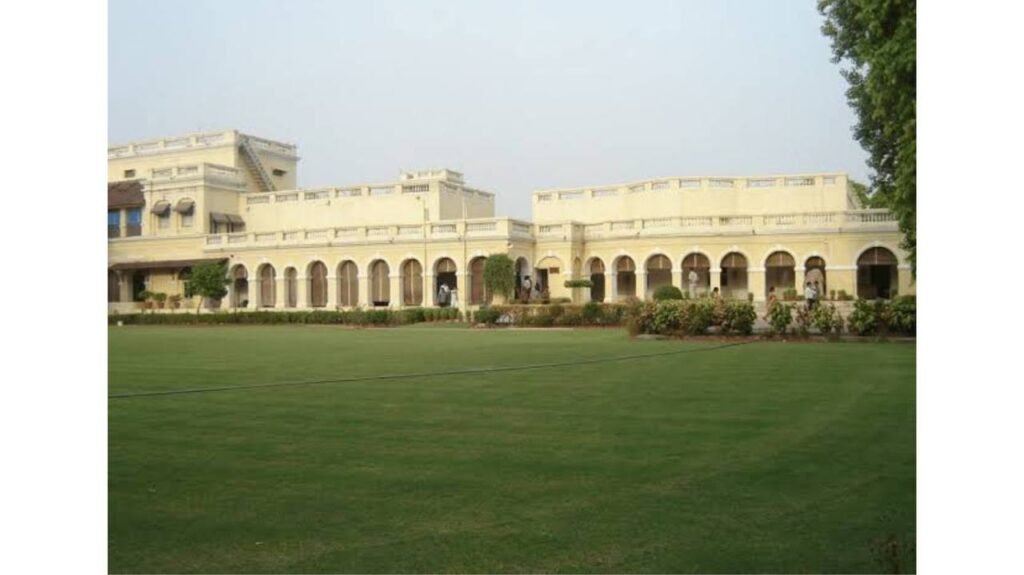
5. Allahabad Museum:
- Significance: Houses a rich collection of archaeological artifacts, including sculptures, coins, and manuscripts.
- Family Fun: Engage in a fascinating journey through time, exploring the region’s history and cultural heritage.
Allahabad Museum: A Journey Through Time
The Allahabad Museum, nestled within the serene Chandrashekhar Azad Park, is a treasure trove of historical and cultural artifacts. Established in 1931, it stands as a testament to the city’s rich heritage and offers a captivating glimpse into the past.
A Rich Tapestry of Collections:
The museum boasts a diverse collection spanning various periods and civilizations, encompassing:
- Archaeological Artifacts:
- A vast array of sculptures, dating back to the ancient period, showcasing the artistic and cultural evolution of the region.
- Pre-historic tools and artifacts, offering insights into the lives of early inhabitants.
- Terracotta figurines and pottery, reflecting the artistic sensibilities of different eras.
- Coins and Currency:
- A comprehensive collection of coins from various dynasties, providing a fascinating glimpse into the history of Indian coinage.
- Paintings:
- A diverse range of paintings, including traditional Indian art forms like Mughal miniatures, Rajput paintings, and contemporary works.
- Arms and Armour:
- An impressive collection of ancient weapons and armor, showcasing the military prowess of past civilizations.
- Prehistoric Art:
- The museum houses one of the largest collections of prehistoric rock paintings in India, offering a unique window into the lives of early humans.
Beyond the Exhibits:
- Research and Education: The Allahabad Museum plays a vital role in research and education, conducting archaeological excavations and organizing workshops and seminars.
- Cultural Hub: The museum serves as a cultural hub, hosting exhibitions, lectures, and other cultural events.
A Family-Friendly Experience:
- Interactive Exhibits: The museum incorporates interactive exhibits to engage visitors, particularly children, making the learning experience more enjoyable and engaging.
- Educational Value: The museum offers a valuable educational experience, providing insights into the history, culture, and art of the region.
Visiting the Allahabad Museum:
- Timings: The museum is generally open from Tuesday to Sunday (closed on Mondays and public holidays).
- Entry Fees: Nominal entry fees apply for visitors.
- Accessibility: The museum is easily accessible by public transportation and is located within walking distance from other major attractions in Prayagraj.
Conclusion:
A visit to the Allahabad Museum Prayagraj is a must for anyone interested in history, art, and culture. This remarkable institution offers a unique opportunity to delve into the past, explore the rich heritage of the region, and gain a deeper understanding of India’s rich cultural tapestry.
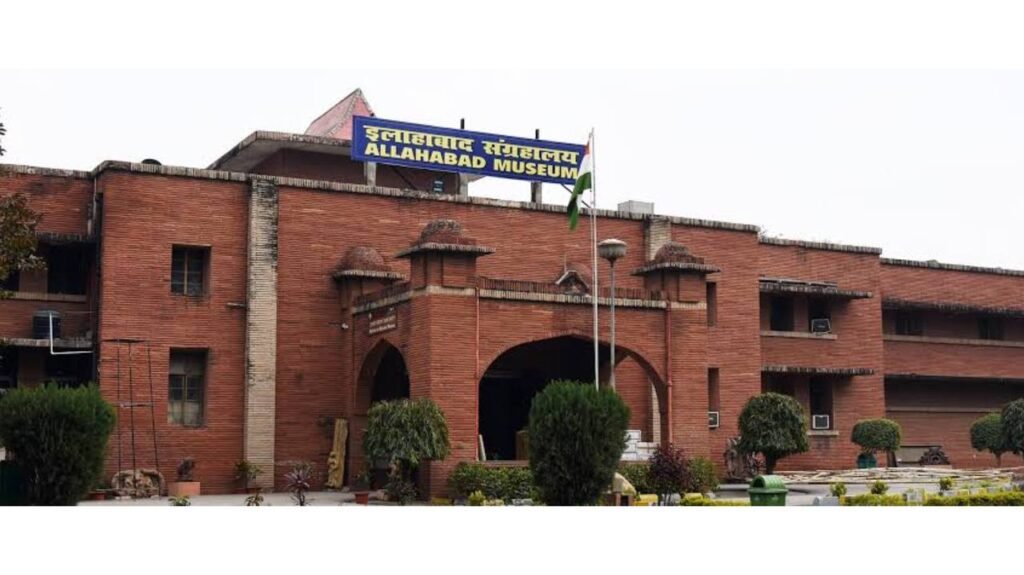
4. Anand Bhavan:
- Significance: The ancestral home of India’s first Prime Minister, Jawaharlal Nehru.
- Family Fun: Explore the beautifully preserved house, learn about Nehru’s life and legacy, and gain insights into India’s freedom struggle.
Anand Bhavan: A Glimpse into the Nehru-Gandhi Legacy
Anand Bhavan, a historic mansion in Prayagraj (formerly Allahabad), holds immense significance in the annals of Indian history. It served as the ancestral home of the illustrious Nehru-Gandhi family, including India’s first Prime Minister, Jawaharlal Nehru. Today, it stands as a testament to the family’s legacy and a significant pilgrimage site for history enthusiasts.
A Glimpse into the Past:
Originally named Swaraj Bhavan, this palatial residence was built by Motilal Nehru in the 1930s. It served as the headquarters of the Indian National Congress during the freedom struggle, witnessing many pivotal moments in the history of India’s independence movement.
- Home to Freedom Fighters: The mansion hosted numerous prominent figures of the Indian National Congress, including Mahatma Gandhi, Sardar Patel, and other eminent leaders.
- A Hub of Political Activity: Swaraj Bhavan witnessed countless meetings, discussions, and strategizing sessions, shaping the course of the Indian freedom struggle.
Transformation to Anand Bhavan:
In 1970, Indira Gandhi, the then Prime Minister of India, donated Swaraj Bhavan to the nation. It was subsequently renamed Anand Bhavan and transformed into a museum, preserving the rich history and legacy of the Nehru-Gandhi family.
Exploring Anand Bhavan:
Today, Anand Bhavan offers visitors a unique glimpse into the lives of the Nehru family and the history of India’s freedom struggle. Key highlights include:
- Jawaharlal Nehru’s Study: A glimpse into the personal and professional life of the first Prime Minister, showcasing his books, personal belongings, and photographs.
- Motilal Nehru’s Library: A well-stocked library reflecting the intellectual pursuits of Motilal Nehru, a prominent lawyer and statesman.
- Photographs and Memorabilia: A collection of photographs, documents, and personal belongings of the Nehru-Gandhi family, offering a fascinating glimpse into their lives.
- The Garden: A serene garden surrounding the mansion, providing a peaceful and contemplative atmosphere.
Significance of Anand Bhavan:
- Historical Importance: Anand Bhavan serves as a living testament to India’s freedom struggle, offering a valuable window into the lives and contributions of the Nehru-Gandhi family.
- Educational Value: It provides an educational experience for visitors, particularly students, to learn about Indian history and the legacy of the freedom movement.
- Cultural Significance: The mansion reflects the architectural style and lifestyle of the era, offering a glimpse into the rich cultural heritage of India.
Visiting Anand Bhavan:
- Timings: The museum is open to the public on most days of the week, with specific timings for visitors.
- Entry Fees: A nominal entry fee is charged for visitors.
- Accessibility: The museum is easily accessible by various means of transportation, including auto-rickshaws, taxis, and local buses.
Conclusion:
A visit to Anand Bhavan Prayagraj is a journey through time, offering a unique opportunity to connect with the rich history of India and the legacy of the Nehru-Gandhi family. It is a must-visit destination for history enthusiasts, students, and anyone interested in exploring the roots of Indian independence.

3. Khusro Bagh:
- Significance: A beautiful Mughal garden with the tombs of Emperor Jahangir’s son, Prince Khusro, and his two wives.
- Family Fun: Stroll through the serene gardens, admire the intricate architecture of the tombs, and learn about Mughal history and culture.
Khusro Bagh: A Mughal Garden of Tranquility Prayagraj
Khusro Bagh, located in Prayagraj, India, is a captivating historical site that offers a glimpse into the grandeur of the Mughal era. This sprawling garden complex, built during the reign of Emperor Jahangir, houses the tombs of his son, Prince Khusro, and his two wives.
A Garden of Remembrance:
- Historical Significance: Khusro Bagh was commissioned by Emperor Jahangir as a final resting place for his beloved son, Prince Khusro, who tragically died in 1622. The garden reflects Jahangir’s deep affection for his son and embodies the Mughal tradition of creating magnificent gardens as memorials.
- Architectural Marvels: The complex features three impressive sandstone tombs, each a testament to Mughal architectural artistry. The tombs are characterized by intricate carvings, delicate latticework, and graceful domes, showcasing the refined aesthetic sensibilities of the Mughal era.
Exploring the Tombs:
- Tomb of Prince Khusro: The central tomb, dedicated to Prince Khusro, stands as a poignant reminder of the tragic fate of the young prince. The tomb is adorned with intricate carvings and features a large dome, creating a sense of tranquility and reverence.
- Tombs of Shah Begum and Nisar Begum: The tombs of Jahangir’s wives, Shah Begum and Nisar Begum, are located within the complex. These structures showcase the elegance and sophistication of Mughal architecture, with their intricate carvings and delicate ornamentation.
Beyond the Tombs:
- Serene Gardens: The Khusro Bagh Prayagraj complex encompasses a large, well-maintained garden, providing a serene and peaceful atmosphere. Visitors can stroll through the lush greenery, admire the beautiful landscaping, and enjoy the tranquility of the surroundings.
- Historical Significance: Exploring Khusro Bagh Prayagraj offers a unique opportunity to delve into the history of the Mughal era, understand the lives and times of the Mughal emperors, and appreciate the grandeur of Mughal architecture.
A Family-Friendly Destination:
Khusro Bagh Prayagraj is a family-friendly destination, offering a peaceful and enriching experience for visitors of all ages. Children can learn about Mughal history and appreciate the beauty of the gardens, while adults can delve deeper into the historical significance of the site.
Tips for Visiting:
- Best Time to Visit: Early morning or late evening are ideal times to visit, avoiding the midday heat.
- Photography: Photography is generally permitted within the complex, allowing visitors to capture the beauty of the architecture and the surrounding gardens.
- Respectful Conduct: Visitors are encouraged to maintain respectful behavior within the complex, honoring the historical and cultural significance of the site.
Khusro Bagh Prayagraj stands as a testament to the grandeur and artistry of the Mughal era. A visit to this historical site offers a unique opportunity to step back in time and experience the rich heritage of India.
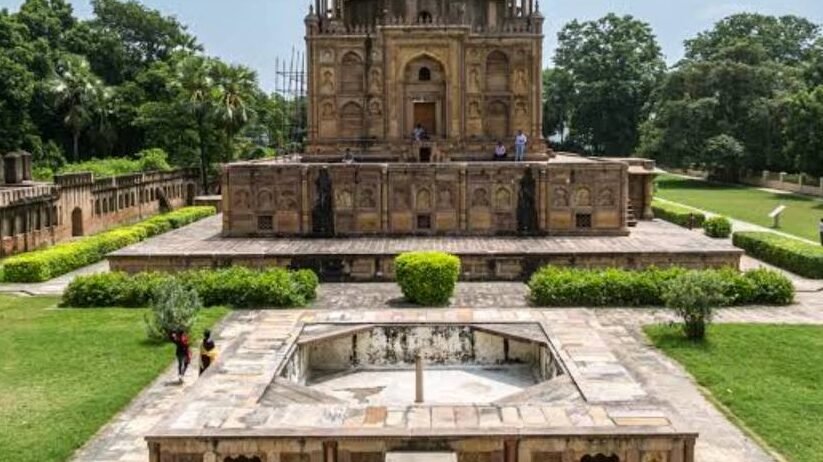
2. Allahabad Fort:
- Significance: A majestic fort with a rich history, built by Emperor Akbar.
- Family Fun: Explore the fort’s impressive architecture, including the magnificent Patalpuri Temple Prayagraj and the serene Jahangir’s Garden. Learn about its historical significance and enjoy panoramic views of the city.
Allahabad Fort: A Glimpse into Mughal Grandeur Prayagraj
The Allahabad Fort, a majestic edifice overlooking the confluence of the Ganga and Yamuna rivers, stands as a testament to India’s rich history and architectural prowess. Built by the Mughal Emperor Akbar in 1583, this imposing fort is a significant landmark in Prayagraj and offers a fascinating glimpse into the grandeur of the Mughal era.
A Monument of Strategic Importance:
Akbar, known for his astute political acumen, strategically chose Allahabad as the location for his fort. The confluence of the two holy rivers held immense religious and cultural significance, making it a crucial point of control. The fort was designed to be an impregnable stronghold, a symbol of Mughal power and authority.
Architectural Marvels:
The Allahabad Fort is renowned for its impressive architecture, blending Mughal and Rajput styles. Key features include:
- Massive Walls: The fort is surrounded by massive stone walls, fortified with bastions and towers, providing a formidable defense.
- Patalpuri Temple: An ancient underground temple located within the fort walls, dedicated to Lord Shiva.
- Jahangir’s Garden: A serene garden within the fort complex, created by Emperor Jahangir, offering a peaceful retreat amidst the imposing structures.
- Ashoka Pillar: A 10-meter-tall polished sandstone pillar erected by Emperor Ashoka in 232 BC, inscribed with royal edicts.
Historical Significance:
The Allahabad Fort has witnessed numerous historical events. It served as a center of power for the Mughals and later became a strategic point for the British East India Company. The fort has played a significant role in shaping the political and cultural landscape of the region.
Visiting the Allahabad Fort:
- Accessibility: The fort is generally open to the public, although access to certain areas may be restricted.
- What to Expect: Visitors can explore the fort walls, admire the architecture, and visit the Patalpuri Temple. The Ashoka Pillar is a major attraction within the fort complex.
- Best Time to Visit: October to March is the ideal time to visit, with pleasant weather.
Conclusion:
The Allahabad Fort is a testament to the grandeur and architectural brilliance of the Mughal era. A visit to this historical landmark offers a unique opportunity to delve into the rich history of India and experience the magnificence of Mughal architecture.
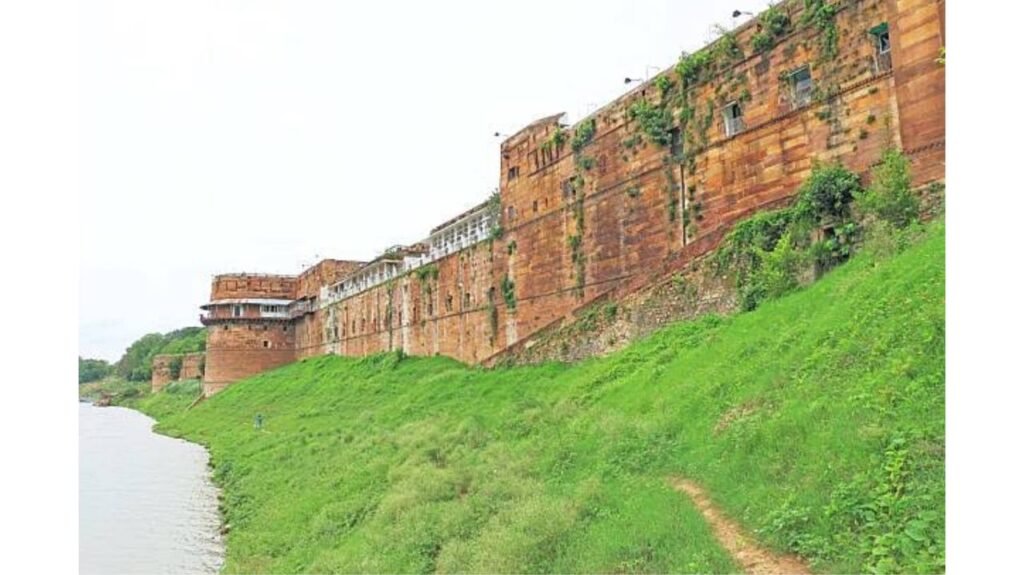
1. Triveni Sangam:
- Significance: The most sacred site in Prayagraj, where the Ganges, Yamuna, and mythical Saraswati rivers converge.
- Family Fun: Witness the mesmerizing Ganga Aarti in the evening, a spectacular display of lights, music, and devotion. Enjoy a boat ride on the river and soak in the spiritual ambiance.
Triveni Sangam: The Sacred Confluence of Rivers
Triveni Sangam, located in Prayagraj (formerly Allahabad), is arguably the most sacred pilgrimage site in Hinduism. It is the confluence point where three holy rivers – the Ganges, the Yamuna, and the mythical Saraswati – are believed to meet.
Religious Significance:
- Mythological Beliefs: Hindus believe that taking a dip in the sacred waters of the Triveni Sangam during auspicious times like Kumbh Mela washes away sins and liberates one from the cycle of rebirth (Moksha).
- Spiritual Significance: The confluence is considered a powerful spiritual center, radiating positive energy and fostering a sense of tranquility. It is believed that prayers offered at the Sangam are particularly potent.
- Kumbh Mela: The Triveni Sangam is the most important site for the Kumbh Mela, a massive Hindu pilgrimage that occurs every 12 years. Millions of devotees gather here to take a dip in the sacred waters during this auspicious period.
Experiencing the Triveni Sangam:
- Ganga Aarti: Witnessing the evening Ganga Aarti at the Triveni Sangam is a truly mesmerizing experience. The banks of the river come alive with the chanting of mantras, the flickering of diyas (oil lamps), and the rhythmic beats of drums.
- Boat Rides: Enjoy a serene boat ride on the Ganges, offering a unique perspective of the confluence and the surrounding landscape.
- Spiritual Immersion: Spend some time in quiet contemplation and introspection, absorbing the spiritual energy of the sacred site.
Beyond the Religious Significance:
- Ecological Importance: The Triveni Sangam is also an ecologically significant site, supporting a diverse range of flora and fauna.
- Cultural Importance: The confluence has played a significant role in Indian history and culture, attracting pilgrims and spiritual seekers for centuries.
Tips for Visiting:
- Best Time to Visit: The Kumbh Mela is a major event, but visiting during other times of the year can offer a more peaceful and less crowded experience.
- Respectful Attire: Dress modestly and respectfully when visiting the Triveni Sangam.
- Photography: Photography is generally allowed, but avoid disturbing the prayers and rituals of other devotees.
- Safety: Be mindful of your belongings and stay hydrated, especially during the summer months.
Conclusion:
The Triveni Sangam is a place of immense spiritual significance and cultural importance. A visit to this sacred site offers a unique opportunity for introspection, spiritual rejuvenation, and a deeper understanding of Hindu mythology and traditions.

Tips for Planning Your Trip:
- Best Time to Visit: October to March is the ideal time to visit Prayagraj, with pleasant weather.
- Accommodation: Choose from a variety of hotels, guesthouses, and ashrams to suit your budget and preferences.
- Transportation: Local transportation options include auto-rickshaws, taxis, and cycle-rickshaws.
- Food: Enjoy delicious local delicacies like ‘bedai puri’, ‘jalebi’, and ‘lassi’.
- Respect Local Customs: Dress modestly when visiting religious sites and be mindful of local customs and traditions.
Conclusion:
Prayagraj offers a unique blend of history, spirituality, and cultural experiences, making it an ideal destination for a family vacation. By exploring these top 10 attractions, you can embark on a journey through time, immerse yourselves in the city’s rich heritage, and create unforgettable memories with your loved ones.
FAQs
Q: What makes Prayagraj a good destination for a family trip?
A: Prayagraj offers a unique blend of religious significance, historical sites, and natural beauty, making it a well-rounded destination for families. It provides opportunities for spiritual experiences, educational exploration, and enjoyable outings for all age groups. The city’s rich history and cultural heritage also offer valuable learning experiences for children.
Q: Are the places on this list suitable for children of all ages?
A: While most places are generally suitable for families, some might be more engaging for certain age groups. For example, parks and gardens are ideal for younger children, while historical sites might be more appreciated by older children and adults. The blog post ideally specifies which places are best suited for different age groups.
Q: What is the best time to visit Prayagraj with family?
A: The best time to visit Prayagraj is during the cooler months, from October to March. This period avoids the extreme heat of the summer months and the monsoon season. The weather is pleasant for sightseeing and outdoor activities during this time.
Q: How can I travel within Prayagraj to visit these places with my family?
A: Prayagraj offers various transportation options, including auto-rickshaws, taxis, and local buses. Depending on your budget and preferences, you can choose the most convenient mode of transport. For larger families, hiring a taxi or booking a car for the day might be a more comfortable option.
Q: Are there any specific things to keep in mind when visiting Prayagraj with family, especially during crowded times like festivals?
A: Yes, it’s important to keep a few things in mind, especially during crowded periods: Safety: Keep a close eye on children in crowded areas.
Hydration: Carry water and stay hydrated, especially during warmer weather.
Food: Be mindful of food hygiene, especially when eating street food.
Accommodation: Book accommodations in advance, especially during peak season or festivals.
Respect local customs: Dress modestly, particularly when visiting religious sites.
Plan your itinerary: Prioritize the places you want to visit and plan your travel accordingly to avoid unnecessary stress.

